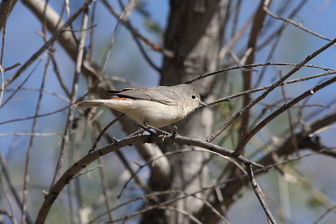Lucy's warbler
It is rather nondescript compared to other wood-warblers. Its head and upperparts are pale gray, while underparts are whitish. It has a white eyering and a small, pointed bill. Both sexes have a rufous rump, a diagnostic field mark. Adult males also have a small rusty crown patch. Juveniles are paler, with a tawny rump and buffy wingbars.

Original source: dominic sheronyPermission(Reusing this file)This image, which was originally posted to Flickr.com, was uploaded to Commons using Flickr upload bot on 22:28, 3 April 2009 (UTC) by Snowmanradio (talk). On that date it was licensed under the license below. This file is licensed under the Creative Commons Attribution-Share Alike 2.0 Generic license.You are free:to share – to copy, distribute and transmit the work
Author: dominic sheronyPermission(Reusing this file)This image, which was originally posted to Flickr.com, was uploaded to Commons using Flickr upload bot on 22:28, 3 April 2009 (UTC) by Snowmanradio (talk). On that date it was licensed under the license below. This file is licensed under the Creative Commons Attribution-Share Alike 2.0 Generic license.You are free:to share – to copy, distribute and transmit the work
The Lucy's warbler is classified as Least Concern. Does not qualify for a more at risk category. Widespread and abundant taxa are included in this category.
and winters in western Mexico, Lucy's Warbler breeds in mesquite bosques, which are often remote. Habitat loss and to a lesser extent, Brown-headed Cowbird parasitism are creating problems for this species, whose populations have been locally extirpated from historical breeding grounds. This is the only warbler besides Prothonotary that nests in cavities. Identification The smallest North American wood-warbler, Lucy's Warbler measures only 4.25 inches in length. More
Lucy's Warbler, Vermivora luciae, is the smallest New World warbler found in North America, measuring a mere 4.25 inches in length. It is rather nondescript compared to other wood-warblers. Its head and upperparts are pale gray, while underparts are whitish. It has a white eyering and a small, pointed bill. Both sexes have a rufous rump, a diagnostic field mark. Adult males also have a small rusty crown patch. Juveniles are paler, with a tawny rump and buffy wingbars. More
The Lucy's Warbler has a large range, estimated globally at 390,000 square kilometers. Native to Mexico and the United States, this bird prefers subtropical or tropical shrubland ecosystems. The global population of this bird is estimated at 1,200,000 individuals and does not show signs of decline that would necessitate inclusion on the IUCN Red List. For this reason, the current evaluation status of Lucy's Warbler is Least Concern. More
Residency: The Lucy's Warbler is a summer resident of Arizona. Diet: This warbler eats mostly caterpillars, beetles and leafhoppers foraged from trees and shrubbery. Predators: Wood rats, Gila Monsters, lizards, and snakes eat eggs. No information on adults. Nesting: Nests are built in pre-existing cavities in velevet mesquite and cottonwood trees. These birds will also use old woodpecker cavities. Nesting Records: Notes: Brown-headed Cowbird parasitism is causing problems for this species. More
One of the smallest warblers, the Lucy's Warbler is a bird of the hot Sonoran desert. It occupies the driest habitat of all the warblers breeding in that area. More
Lucy's Warblers inhabit riparian mesquite and brushy country of the southwestern United States and northwestern Mexico. Lucy's is the only warbler besides Prothonotary to nest in cavities. Habitat loss and to a lesser extent, Brown-headed Cowbird parasitism are threatening this species, and populations are diminishing throughout its breeding range. The birds migrate to western Mexico in winter. These strictly insectivorous birds forage actively, looking for the caterpillars, beetles, and leafhoppers that compose much of their diet. More
Lucy's Warbler in Oregon: Only Second Record in State History! Return to News Index Page Sheila Chambers first discovered an unusual, small gray bird in her bushes in January 2004. More
Bent Life History for the Lucy's Warbler - the common name and sub-species reflect the nomenclature in use at the time the description was written. LUCY'S WARBLER VERMIVORA LUCIAE (Cooper) HABITS Dr. J. G. Cooper discovered this tiny and inconspicuous warbler at Fort Mojave, on the Arizona side of the Colorado River, in the spring of 1861, and named it in honor of Miss Lucy Baird, daughter of Prof. Spencer F. Baird. More
Lucy's Warbler is closely related to Virginia's Warbler, Nashville Warbler and Colima Warbler. The common name and binomial of this species commemorate Lucy Hunter Baird, daughter of ornithologist Spencer Fullerton Baird. More
Lucy's Warbler is a neotropical migrant that summers in lowland areas of the southwest, although they occasionally nest in sycamore-oak associations as high as 1,775 m elevation (Johnson et al. 1997). Its breeding range extends from southeast California through extreme southern portions of Nevada and Utah, and through western and southern Arizona and New Mexico. The breeding range also extends south into northern portions of Baja California and Sonora. More
The Lucy's Warbler is a monotypic species (Johnson et al. 1997) with no geographic variation described (Dunn and Garrett 1997). MANAGEMENT STATUS: The Lucy's Warbler is not listed as threatened or endangered and there are no special conservation measures proposed either at the federal or state level (Johnson et al. 1997). More
Family : Parulidae
Genus : Vermivora
Species : luciae
Authority : (Cooper, 1861)

